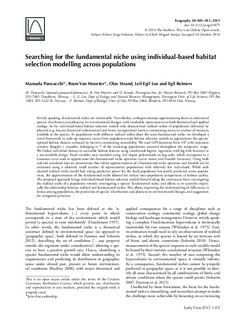| dc.description.abstract | Strictly speaking, fundamental niches are inestimable. Nevertheless, ecologists attempt approximating them to understand
species ’ distribution and plasticity to environmental changes, with invaluable repercussions on both theoretical and applied
ecology. So far, individual-based habitat selection models only characterized realized niches of populations delimited by
physical (e.g. fences), historical (colonization) and biotic (competition) barriers constraining access to a subset of resources
available to the species. As populations with diff erent realized niches share the same fundamental niche, we developed a
novel framework to scale-up response curves from population-scale habitat selection models to approximate the species ’
optimal habitat choices, unbiased by barriers constraining accessibility. We used GPS-locations from 147 wild mountain
reindeer Rangifer t. tarandus , belonging to 7 of the remaining populations scattered throughout the subspecies ’ range.
We linked individual choices to accessible habitat features using conditional-logistic regression with log-link function in
a use-available design. Focal variables were modeled using 2nd degree polynomials on log-scale, which correspond to a
Gaussian curve used to approximate the fundamental niche optimum (curve mean) and breadth (variance). Using both
real and simulated data we demonstrate that robust approximations of a fundamental niche optimum and breadth can be
estimated using a relatively small number of representative populations with relatively few individuals. While each
classical realized niche model had strong predictive power for the focal population but poorly predicted across populations,
the approximation of the fundamental niche allowed for robust inter-population comparisons in habitat quality.
Th e proposed approach brings individual-based habitat selection models forward along the continuum from investigating
the realized niche of a population towards investigating a species ’ fundamental niche, and allows us to quantify empirically
the relationship between realized and fundamental niches. Th is allows improving the understanding of diff erences in
fi tness among populations, the prediction of species ’ distributions and plasticity to environmental changes, and suggestions
for mitigation priorities. | nb_NO |

